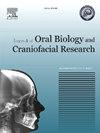Assessment of stress levels in mothers of children with autism spectrum disorder using video self-modeling during children's dental procedure
Q1 Medicine
Journal of oral biology and craniofacial research
Pub Date : 2025-05-23
DOI:10.1016/j.jobcr.2025.05.005
引用次数: 0
Abstract
Background
Autism Spectrum Disorder (ASD) is a neurodevelopmental condition affecting social interaction, communication, and behavior. Mothers of children with ASD often experience chronic stress, leading to dysregulation of the hypothalamic-pituitary-adrenal (HPA) axis and low cortisol levels. Salivary cortisol, a non-invasive biomarker, reflects physiological stress responses. Effective behavior guidance in pediatric dentistry can improve the dental experience for children with ASD and reduce maternal stress. Video self-modeling (VSM) is a promising intervention to enhance cooperation in children with ASD during dental procedures.
Aim
This study aimed to estimate the salivary cortisol levels in the mothers of children with ASD following the application of VSM as a behavior guidance technique for their children during dental procedures.
Materials and methods
Twenty-two mothers of children with ASD (aged 6–12 years) participated. Salivary cortisol samples were collected at baseline and two weeks post-intervention. Cortisol levels were measured using enzyme-linked immunosorbent assay (ELISA), and a paired t-test compared pre- and post-intervention levels.
Results
Pre-intervention cortisol levels ranged from 13.35 ng/ml to 63.35 ng/ml (mean 33.2 ± 15.8 ng/ml). Post-intervention levels increased, ranging from 13.35 ng/ml to 55.52 ng/ml and difference was statistically significant (mean 44.2 ± 10.1 ng/ml; t = −2.53, p = 0.019).
Conclusion
This study highlights the bidirectional relationship between child behavior and maternal stress. VSM improved cooperation in children with ASD during dental procedures and positively impacted maternal stress, as shown by increased salivary cortisol, thus emphasizing the need for behavior interventions benefiting both children and their families.
在儿童牙科治疗过程中使用视频自我模拟评估自闭症谱系障碍儿童母亲的压力水平
自闭症谱系障碍(ASD)是一种影响社会互动、沟通和行为的神经发育疾病。患有ASD儿童的母亲经常经历慢性压力,导致下丘脑-垂体-肾上腺轴(HPA)失调和低皮质醇水平。唾液皮质醇是一种非侵入性生物标志物,反映生理应激反应。有效的儿童牙科行为指导可以改善ASD患儿的牙科体验,减轻产妇压力。视频自我建模(VSM)是一种很有前途的干预措施,可以增强ASD儿童在牙科手术中的合作。目的本研究旨在评估应用VSM作为儿童牙科手术行为指导技术后ASD儿童母亲唾液皮质醇水平的变化。材料与方法22名6-12岁ASD患儿母亲参与研究。在基线和干预后两周收集唾液皮质醇样本。采用酶联免疫吸附试验(ELISA)测量皮质醇水平,并采用配对t检验比较干预前和干预后水平。结果干预前皮质醇水平为13.35 ~ 63.35 ng/ml(平均33.2±15.8 ng/ml)。干预后水平升高,从13.35 ng/ml到55.52 ng/ml不等,差异有统计学意义(平均44.2±10.1 ng/ml;T =−2.53,p = 0.019)。结论本研究强调了儿童行为与母亲应激之间的双向关系。VSM改善了ASD儿童在牙科手术期间的合作,并积极影响了母亲的压力,如唾液皮质醇的增加所示,因此强调了对儿童及其家庭都有益的行为干预的必要性。
本文章由计算机程序翻译,如有差异,请以英文原文为准。
求助全文
约1分钟内获得全文
求助全文
来源期刊

Journal of oral biology and craniofacial research
Medicine-Otorhinolaryngology
CiteScore
4.90
自引率
0.00%
发文量
133
审稿时长
167 days
期刊介绍:
Journal of Oral Biology and Craniofacial Research (JOBCR)is the official journal of the Craniofacial Research Foundation (CRF). The journal aims to provide a common platform for both clinical and translational research and to promote interdisciplinary sciences in craniofacial region. JOBCR publishes content that includes diseases, injuries and defects in the head, neck, face, jaws and the hard and soft tissues of the mouth and jaws and face region; diagnosis and medical management of diseases specific to the orofacial tissues and of oral manifestations of systemic diseases; studies on identifying populations at risk of oral disease or in need of specific care, and comparing regional, environmental, social, and access similarities and differences in dental care between populations; diseases of the mouth and related structures like salivary glands, temporomandibular joints, facial muscles and perioral skin; biomedical engineering, tissue engineering and stem cells. The journal publishes reviews, commentaries, peer-reviewed original research articles, short communication, and case reports.
 求助内容:
求助内容: 应助结果提醒方式:
应助结果提醒方式:


